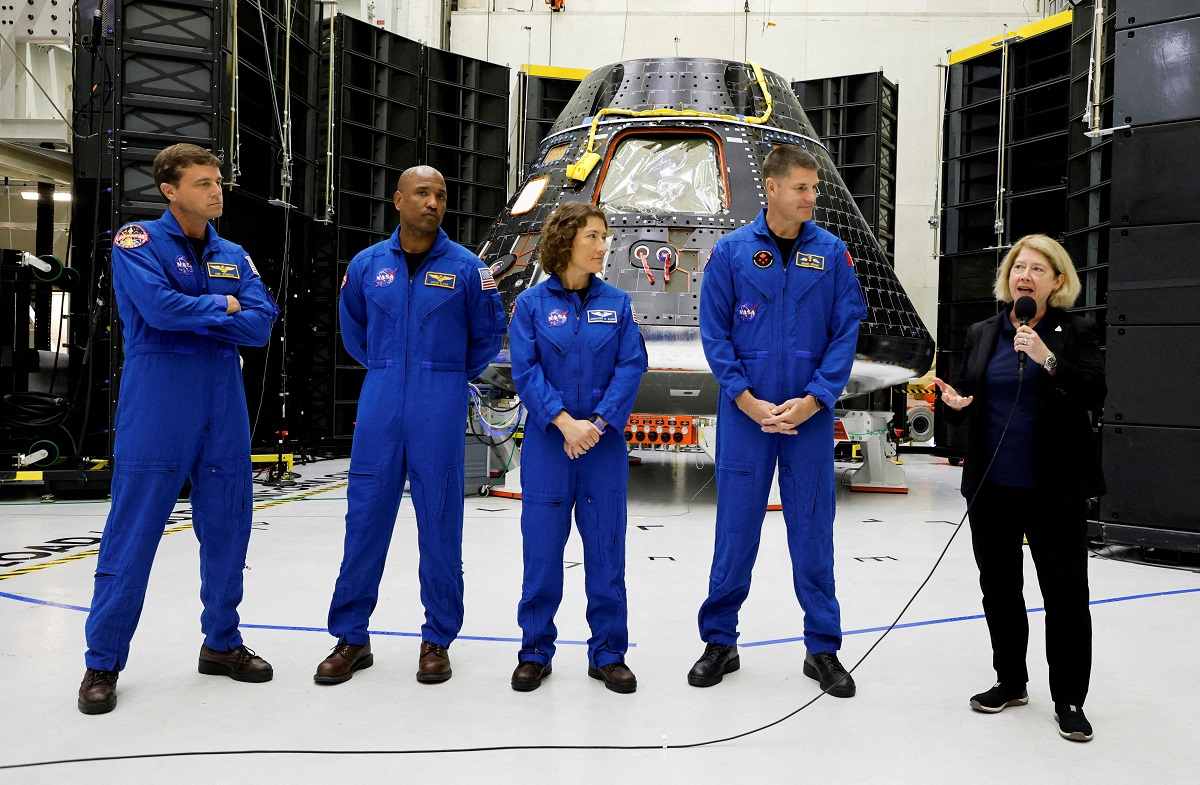
Astronauts for NASA’s Artemis II mission stand in front of their Orion crew capsule, expected to carry Reid Wiseman, commander, Victor Glover, pilot, and mission specialists Christina Hammock Koch and Jeremy Hansen, with the Canadian Space Agency, as NASA Deputy Administrator Pam Melroy speaks at a press conference at the Kennedy Space Center in Cape Canaveral, Florida, U.S., August 8, 2023.
13:01 JST, January 9, 2024
WASHINGTON (Reuters) – NASA is set to delay its next few missions to the moon under a key program as technical hurdles mount with the various spacecraft it intends to use to get there, according to four people familiar with NASA’s plans.
The U.S. space agency is expected to announce the plans on Tuesday after spending months tracking progress with contractors and considering changes to the Artemis program, a multi-billion dollar effort that includes returning the first astronauts to the moon since the last Apollo mission in 1972.
NASA’s second Artemis mission is expected to be pushed beyond its planned late-2024 target after issues were uncovered with the Lockheed Martin-built LMT.N Orion crew capsule’s batteries during vibration tests, two of the people said. The batteries will need to be replaced.
This would have been the first flight with humans aboard after launching the capsule uncrewed atop NASA’s Space Launch System in a 2022 inaugural test.
Artemis 3 – planned to be the first mission landing humans on the moon in late 2025 using the Starship landing system from NASA contractor SpaceX – will likewise be pushed back. Billionaire Elon Musk’s SpaceX is taking longer than expected to reach certain development milestones, all four people said.
NASA declined to comment. Lockheed and SpaceX did not immediately return requests for comment.
Senior NASA officials in recent months have been mulling plans to move the inaugural Artemis astronaut landing to the fourth mission, giving SpaceX and other contractors more practice before making the first such landing in half a century.
NASA officials presented that option to the agency’s senior leadership last month, but it could not be determined if it chose that path. It was also unclear what the new target dates for the initial Artemis missions would be.
NASA’s Artemis program relies heavily on private companies. It will use the Boeing BA.N and Northrop Grumman-led NOC.N Space Launch System to loft humans off Earth, Lockheed’s Orion capsule to propel them toward the moon and SpaceX’s Starship to take them on and off the lunar surface.
Billionaire Jeff Bezos’ Blue Origin is also developing an astronaut lander for later missions.
Complex development milestones with SpaceX’s giant Starship system include the company’s plan to refuel Starship at an orbital propellant depot before the ship can take humans to the lunar surface and launch them back with enough fuel.
NASA is eager to see SpaceX make progress on the orbital refueling plan, seeing it as a potential bottleneck that entails the delicate transfer of thousands of gallons of supercooled, flammable propellants in orbit, three of the people said.
"News Services" POPULAR ARTICLE
-

American Playwright Jeremy O. Harris Arrested in Japan on Alleged Drug Smuggling
-

Japan’s Nikkei Stock Average as JGB Yields, Yen Rise on Rate-Hike Bets
-

Japan’s Nikkei Stock Average Licks Wounds after Selloff Sparked by BOJ Hike Bets (UPDATE 1)
-

Japanese Bond Yields Zoom, Stocks Slide as Rate Hike Looms
-

Japan’s Nikkei Stock Average Buoyed by Stable Yen; SoftBank’s Slide Caps Gains (UPDATE 1)
JN ACCESS RANKING
-

Keidanren Chairman Yoshinobu Tsutsui Visits Kashiwazaki-Kariwa Nuclear Power Plant; Inspects New Emergency Safety System
-

Imports of Rare Earths from China Facing Delays, May Be Caused by Deterioration of Japan-China Relations
-

University of Tokyo Professor Discusses Japanese Economic Security in Interview Ahead of Forum
-

Japan Pulls out of Vietnam Nuclear Project, Complicating Hanoi’s Power Plans
-

Govt Aims to Expand NISA Program Lineup, Abolish Age Restriction

























